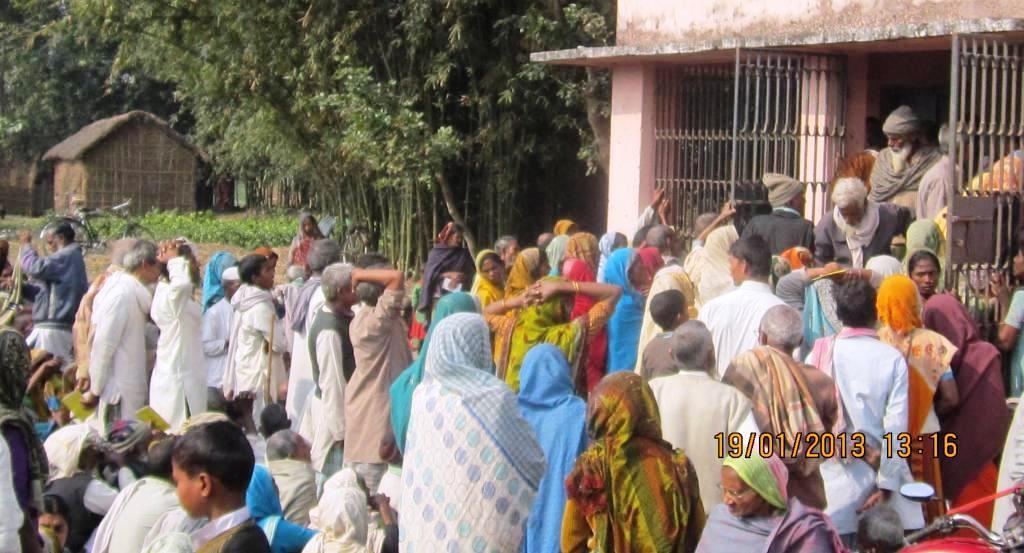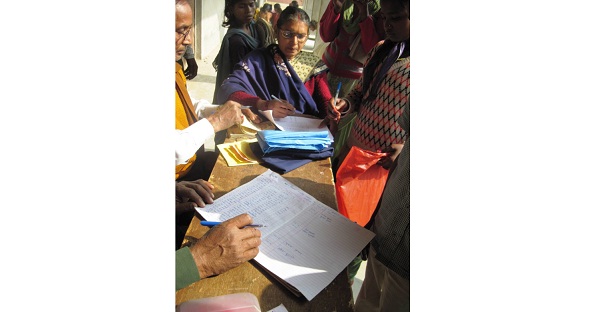
All for One and None for Another? Entitlements, Attendance and Conditional Cash Transfers in Bihar: Part II
11 February 2013
Since mid-January, Bihar’s public schools have seen great activity as an ambitious campaign to distribute student entitlements was rolled out. These entitlements are given out each year; however, this year there is an added twist in the form of a required attendance rate of 75 per cent between April and September 2012 to be eligible. As mentioned in my last post, the second part of my blog discusses the efficacy with which the distribution campaign has been designed and implemented in Bihar over the past few weeks. It also touches upon the scope for conditional cash transfers in the Indian education context.
Lack of timely communication and preparation
As per the directions of the Government of Bihar (GoB), after instructions and details of the campaign had been shared with headmasters and teachers, lists of eligible students were to be submitted to block officials by January 4th. These were then to be forwarded to the District. What I witnessed, however, was a huge delay in sharing this information with the headmasters and teachers, as well as the larger community. In Nalanda, for instance, headmasters were not informed of the date when the camp was to be held in their schools until January 12th, only three days before the campaign was due to start. Coordination at the district-level had been difficult and, till the 14th, locations of where the camps were to be held were still being finalised. While the number of Panchayats to be covered had been decided upon earlier, the actual schools had not.[1] In Purnea, due to delays in the collection of lists of beneficiaries and of correct school bank account numbers, the campaign started four days late (on January 19th).
More importantly, the details and rationale behind the new conditionality attached to the benefits were not explained in advance to the students and their families. What ensued as a consequence was considerable agitation from parents and students, questioning why some students have not received the benefits.. For instance in Purnea, the first day of the camp (January 19th) saw a massive protest at the Purnea Collectorate by high school girls demanding cycles for all students (Hindustan, January 20, 2013). Students and parents have also been reported to hold protests by blocking roads and highways in Purnea and its neighbouring district of Kishanganj. In other cases, under pressure from the local community, headmasters have felt obligated to distribute cash to those students without the requisite attendance rates. Thus, it’s clear that the GoB did not have a strong enough communication strategy and this has led to significant implementation problems at all levels of the system.

Parents at a school in Purnea demanding why their children were not being given their entitlements as well (January 2013)
Inconsistencies, delays and irregularities in fund-transfers
Aside from this, there have been logistical problems related to fund transfers as well. In Nalanda, district-to-school fund transfers, albeit made online through the Real-Time Gross Settlement system (RTGS), were only made on January 12th, three days before the campaign was supposed to start. By the first day of the camp on the 15th, funds still had not arrived in the Panchayat we had visited. Instead, the teachers were busy disbursing uniform money that was to have been distributed in 2011-12! The district administration had directed that any funds left-over from the previous year, for instance because of lack of students’ bank accounts being opened, were to be distributed during this camp as well. There were also stark inconsistencies noticed in the implementation mechanism between districts. In Purnea, in contrast, not only was the campaign delayed, but excess funds were being transferred to schools. To illustrate, instead of transferring funds based on the number of eligible students, every school was transferred funds according to a formula of 75 per cent of the total student enrolment. Thus, if a school had 100 students, entitlements for 75 per cent would be transferred. Any funds left over were then to be returned to the district. Furthermore, no mention has been made in Purnea regarding the disbursal of any funds remaining from FY 2011-12.
Lack of strict monitoring
These instances are only the tip of the iceberg. As pointed out in Part I of my blog, it is widely accepted by the administration and teachers that attendance rates in Bihar are low (see PAISA District Studies 2011 for more details). Compounding the problem of linking attendance to benefits is the contributing factor of double enrolment (that is, children enrolled in both government and private schools) [2] Thus, even before the campaign had begun, state-level officials anticipated two developments on the ground: a. manipulation of data;[3] or b. backing away from the true data that comes out. However, apart from the internal and external monitoring mechanisms already in place (mentioned in my previous blog) no explicit measures to address these problems were shared, nor any to verify the data generated at the school-level. As mentioned above, parents are already questioning the veracity of the lists submitted and demanding that these numbers not be taken into consideration. In a significant number of visits we had made, we did not find the presence of public representatives or other officials. Even on the first day of the campaign in Nalanda, the Mukhiya (Gram Panchayat President) did not venture out of the Block Resource Centre adjacent to the school where the camp was being held.
Where officials did go, they had a tough time explaining the campaign’s rationale and details to parents and guardians. Moreover, in Purnea, district- and block-level officials were observed questioning headmasters during a school-visit about the distribution, but it remains to be seen what kind of reporting will be done and follow-up action taken in cases where any kind of mismanagement is discovered. At a monthly block-level meeting held in Purnea on February 4, it was observed the Block Education Officer (BEO) asked all headmasters present to certify they had only given out entitlements to those students who had 75 percent attendance. This was done without asking for any verification of the same and, of course, all present duly provided their certifications. Currently, there is no way of knowing the extent to which teachers and headmasters have used their own discretion to decide which students are eligible. Therefore, the question also arises as to whether students from marginalised backgrounds have truly been covered or not.

Block official explaining details of the distribution camp to students (left) and students receiving their entitlement for uniforms – due to them from the previous year, FY 2011-12 (right).

Based on a “voucher drawal” system, cloth and receipts (also called “vouchers”) are examined by teachers before the cash entitlement for uniforms is handed out. The headmaster at this school shared that, in case it is different from the norm specified, a student will be reimbursed only the amount that she has spent. Students signed three registers in this school – one for the school’s records and two to be submitted to the administration.
Furthermore, issues related to corruption and security may also arise; according to field reports, no explicit monitoring is being undertaken to ensure that the amount withdrawn from the school’s bank account is the total amount that is actually distributed. Given these situations, stricter monitoring of these camps, both internal and external, is imperative.
What next?
There are several issues and challenges associated with this campaign and with such conditional cash transfers in general.[4]
First, three to four weeks has clearly not been enough time to lay the ground-work for such an ambitious campaign. Logistics have been hard to coordinate and field-work in both districts reveals that, till date, funds for uniforms are being distributed more regularly while the distribution of other benefits has been slow. Complete funds for FY 2012-13 have not yet been received in all schools. Reports now point to the campaign extending at least into the first two weeks of February; at this rate, the amount of disruption in classroom learning would become quite significant. Not only that, if this form of entitlement distribution is to be institutionalised in the state in coming years, then clearly the timing and means of communication at all levels needs to be thought through further. Second, the appropriateness of such conditional cash transfers in the Bihar public education context needs more debate. Given Bihar’s past experience with low attendance and double enrolment, a strong argument can be made for linking entitlements with attendance; teachers and administrators already do. However, as my colleague Uthara wrote recently, “[t]he efficacy of a cash transfer scheme, like all other schemes, would […] depend largely on its specific design, and how well suited it is to the context to which it is being applied.” A cash transfer scheme is usually designed to reduce delays and leakages in benefits reaching the target populations. In this case, with the added conditionality of 75 per cent attendance between April and September, the issue of delays would still not be addressed, since the earliest students would get their benefits would be October.
Aside from the communication and implementation problems described earlier and the fact that this campaign is in conflict with Right to Education (RTE) norms, what is more worrying is that it is seen as an end in itself. Such conditional cash transfers may well work to incentivise children to attend school in the short-term. However, in a supply-driven system such as the Sarva Shiksha Abhiyan, without a focus or link with the larger issues, such as quality of teaching-learning, teacher absenteeism, good quality physical infrastructure, adequate monitoring and sanctions, and community empowerment and involvement, it is hard to see this campaign achieving sustained attendance rates in the long-run. Without empowering parents and communities to take greater ownership of their schools, doling out conditional incentives may not lead to long-term change in Bihar’s government schools. Thus, more rigorous planning, learning from the experience of other countries (such as rigorous trials in Mexico, Brazil and elsewhere), and linking these incentives to the larger objective and context of quality education are the need of the hour.
Acknowledgments: Dinesh Kumar and Seema Muskan, PAISA Associates in Nalanda and Purnea districts, contributed to this blog with reports from the field.
[1]At least some blocks in Nalanda had conveyed camp dates to headmasters during a special meeting held on January 12 (a Saturday); it may be possible that these were not shared with the District Administration until later. Headmasters shared that not enough notice was given to them regarding the camp dates since schools had closed in the first week of January due to unexpectedly cold weather.
[2] According to the Annual Status of Education Report (Rural) 2012, the proportion of students enrolled in private schools in rural Bihar is around 10 per cent in 2012 for Standards II and IV. While an increasing trend is observed for these Standards between 2008 and 2012, the opposite is observed for Standards VI and VIII over the same period. In contrast, overall rural India figures point to a consistently increasing trend for all four Standards.
[3] In this case, “manipulation of data” implies the inflation of student attendance rates.
[4] See here for my colleague Uthara’s blog on cash transfers entail and here for Accountability Initiative’s compendium of resources on direct cash transfers. The World Bank’s Policy Research Report on conditional cash transfers can be accessed here.





